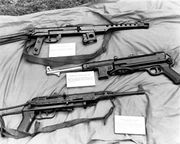PPSh-41
| PPSh-41 | |
|---|---|
 PPSh-41 |
|
| Type | Submachine gun |
| Place of origin | |
| Service history | |
| In service | 1941–Present |
| Used by | See Users |
| Wars | |
| Production history | |
| Designer | Georgi Shpagin |
| Manufacturer | Numerous |
| Produced | 1941 |
| Number built | Approx. 6,000,000 |
| Variants | See Variants |
| Specifications | |
| Weight | 3.63 kg (8 lb)(without magazine) |
| Length | 843 mm (33.2 in) |
| Barrel length | 269 mm (10.6 in) |
|
|
|
| Cartridge | 7.62x25mm Tokarev |
| Action | Blowback, open bolt |
| Rate of fire | 900 rounds/min[2] |
| Muzzle velocity | 488 m/s (1,600.6 ft/s) |
| Effective range | 200 m |
| Feed system | 35-round box magazine or 71-round drum magazine |
| Sights | Iron sights |
The PPSh-41 (Pistolet-Pulemyot Shpagina; Russian: Пистолет-пулемёт Шпагина; "Shpagin machine pistol") submachine gun was one of the most mass produced weapons of its type in World War II. It was designed by Georgi Shpagin as an inexpensive alternative to the PPD-40. The PPSh operated with simple blowback action, had a box or drum magazine, and fired the 7.62x25mm pistol round. It was made with metal stampings to ease production, and its chrome-lined chamber and bore helped to make the weapon very low-maintenance in combat environments.
Contents |
History
The impetus for the development of the PPSh came partly from the Winter War against Finland, where it was found that submachine guns were a highly effective tool for close-quarter fighting in forests or built-up urban areas. The weapon was developed in mid-1941 and was produced in a network of factories in Moscow, with high-level local Party members made directly responsible for production targets being met.
A few hundred weapons were produced in November 1941 and another 155,000 were produced over the next five months. By spring 1942, the PPSh factories were producing roughly 3,000 units a day.[3] The PPSh-41 was a classic example of a design adapted for mass production (other examples of such wartime design were the M3 submachine gun, MP40 and the Sten). Its parts (excluding the barrel) could be produced by a relatively unskilled workforce with simple equipment available in an auto repair garage or tin shop, freeing up more skilled workers for other tasks. The PPSh-41 used 87 components compared to 95 for the PPD-40 and the PPSh could be manufactured with 7.3 machining hours compared with 13.7 hours for the PPD.[4]
In the field, the PPSh was a durable, low-maintenance weapon that could fire 900 rounds/min. The weapon had a crude compensator to lessen muzzle climb and a hinged receiver which facilitated field-stripping and cleaning the bore in battle conditions.
Over 6 million of these weapons were produced by the end of the war. The Soviets would often equip whole regiments and even entire divisions with the weapon, giving them unmatched short-range firepower. Though 35-round curved box magazines were available from 1942, the average infantryman would keep a higher-capacity, 71 round, drum magazine as the initial load.[2] The PPSh-41 drum magazine was a copy of the Finnish M31 Suomi magazine which held 71 rounds, but in practice, misfeeding of the spring was likely to occur with more than 65 or so cartridges.[5] The standard load was probably one drum and a number of box magazines, when box magazines were available.
Features
Some of the PPSh's drawbacks included the difficulty of reloading, the tendency of the drums to jam (solved by the box magazines) and the high risk of accidental discharge when dropped - the last being a fault common to all open bolt submachine gun designs. Despite these drawbacks, the PPSh-41 was still admired by Soviet soldiers for its low recoil, reliability, and lethality at close range. The PPSh fired the standard 7.62x25mm pistol round such as used in the TT-33 pistol.
The captured PPSh was in particular a favorite weapon of the Germans. Because of the similarities between the 7.62x25mm Tokarev and the 7.63x25mm Mauser cartridge used in the Mauser C96 pistol, the PPSh was easily supplied with ammunition. In fact so many were captured that it became the second-most-common submachinegun used by German forces. Attempts were also made to convert the weapon to 9mm Parabellum to conform to German logistics. The Wehrmacht officially adopted the converted PPSh-41 as the MP41(r); unconverted PPSh-41s were designated MP717(r) and supplied with 7.63x25mm Mauser ammunition (which is dimensionally identical to 7.62x25mm, but somewhat less powerful). German-language manuals for the use of captured PPShs were printed and distributed in the Wehrmacht.[6]
During the war the PPS, an even more simplified submachine gun, was introduced in Soviet service, although it did not replace the PPSh-41 during the war.
Users
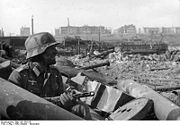
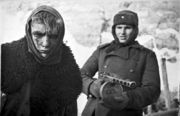
 Hungary: Captured and reissued PPSh-41s in the early 1940s.[7]
Hungary: Captured and reissued PPSh-41s in the early 1940s.[7]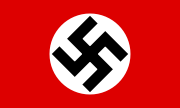 Nazi Germany: Used captured and converted PPSh-41s.[6]
Nazi Germany: Used captured and converted PPSh-41s.[6]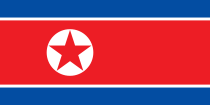 North Korea: Made licensed copies under the designation Type 49.[8]
North Korea: Made licensed copies under the designation Type 49.[8]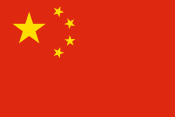 People's Republic of China: Made unlicensed copies under the designation Type 50.[9]
People's Republic of China: Made unlicensed copies under the designation Type 50.[9]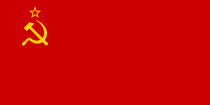 Soviet Union: Entered service with the Soviet Army in 1942.[9]
Soviet Union: Entered service with the Soviet Army in 1942.[9] Vietnam[2]
Vietnam[2]
Variants
- Type 50: A Chinese-made version of the PPsh-41. Unlike its Soviet counterpart, it only accepts stick-based magazines.[8]
- Type 49: A North-Korean made version of the PPsh-41. This model only accepts drum-based magazines.[8]
- K-50M: A Vietnamese-made submachine gun based on the Type 50s supplied by China during the Vietnam War. The chief difference was that the cooling sleeve of the K-50 was truncated to three inches and a foresight based on that of the French MAT-49 was attached to the front of the barrel.[10] Modifications include the addition of a pistol grip, a steel wire-made stock and the shortened barrel.[11] The changes made the K-50 much lighter by 500 g (1.1 lb) lighter than the PPSh41 at 3.4 kg (7.5 lb) as opposed to 3.9 kg (8.6 lb).[12] The weapon uses a 35-round stick magazine, but the 71-round drum magazine can be used if the stock was fully retracted.[11]
- In 2008, a semi-automatic version of the PPSh-41 became available as SKL-41 on the German market. This version is converted to fire the 9mm Parabellum cartridge. Aside from replicas of its original magazines, it also accepts MP 40 magazines.
See also
- List of submachine guns
- List of Russian Weaponry
References
- ↑ 1.0 1.1 1.2 Bishop, Chris. Guns in Combat. Chartwell Books, Inc (1998). ISBN 0-7858-0844-2.
- ↑ 2.0 2.1 2.2 "Shpagin PPSh-41 submachine gun (USSR)". http://world.guns.ru/smg/smg02-e.htm. Retrieved 2010-03-21.
- ↑ Rodric Braithwaite, Moscow 1941: A City and its People at War, London: Profile Books, 2006, p. 236.
- ↑ "Kalashnikov, Part 2: Soviet Political Economy and the Design Evolution of the Kalashnikov Avtomat". http://www.cruffler.com/trivia-March01.html. Retrieved 2010-03-21.
- ↑ Mosier, The Blitzkrieg Myth, p.86.
- ↑ 6.0 6.1 "9 mm Conversion of the PPSh-41". http://www.ppsh41.com/ppsh2.html. Retrieved 2010-03-21.
- ↑ "7.62mm Submachine Gun PPSh41". http://www.sunblest.net/gun/PPSh41.htm. Retrieved 2010-03-21.
- ↑ 8.0 8.1 8.2 US Department of Defense, North Korea Country Handbook 1997, Appendix A: Equipment Recognition, PPSH 1943 SUBMACHINEGUN (TYPE-50 CHINA/MODEL-49 DPRK), p. A-79.
- ↑ 9.0 9.1 Miller, David (2001). The Illustrated Directory of 20th Century Guns. Salamander Books Ltd. ISBN 1-84065-245-4.
- ↑ "PPSh41 Sub Machine Gun". http://www.vietnam-war.info/weapons/ppsh41_sub_machine_gun.php. Retrieved 2009-01-17.
- ↑ 11.0 11.1 "Modern Firearms' K-50M Submachine Gun". http://world.guns.ru/smg/smg109-e.htm. Retrieved 2009-01-17.
- ↑ "VC Weapons". http://www.skysoldier17.com/vc_weapons.htm. Retrieved 2009-01-17.
Bibliography
- Hogg, Ian (2000). Jane's Guns Recognition Guide Second Edition. Glasgow: Janes. ISBN 0-00-472453-4.
External links
- Video of PPSh being fired with drum magazine
- Video of PPSh being fired in burst with 9 mm conversion
- 17 photos of PPSh41 and its parts
|
||||||||||||||||||||
